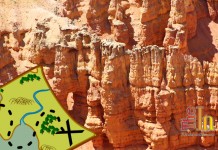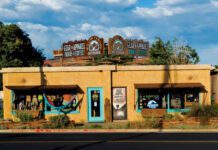
Written by Marcos Camargos
Dixie State University celebrated Martin Luther King Day by dedicating a light post to the great Civil Rights leader. I’d like to commend the University for extending an olive branch of tolerance after nearly a century of being steeped in Confederate segregationist fervor, followed by two decades of downplaying racist school traditions. But perhaps a light post is a little beneath Dr. King who, in my opinion, deserves something a bit more dignified. For example, maybe DSU should commission a bronze statue in honor of MLK — a statue say similar in prominence to the one that depicted a Confederate soldier and graced the entrance to the school from 1983 to 2012.
So how did a college in Utah become so obsessed with the Confederacy and slavery?
I first heard of DSU shortly after moving to Provo in 2003. Having grown up in Oregon I thought it strange that a college in Utah would adopt a name associated with the antebellum South. When I asked a friend how Dixie got its name, she told me the first Mormon settlers in this region grew cotton. Because of cotton’s traditional link to the southern states, Brigham Young named this area Dixie as a marketing ploy, a way to get potential buyers interested in purchasing cotton from Utah. But, like so many historical narratives, there is much more to the story.
Young did intend to grow cotton, so he chose Mormons from the deep South to settle this region. However, it became apparent within only a few years that an economy built on cotton was not viable, and the project was abandoned. But the name stuck, and like a self-fulfilling prophecy, the school tradition began to include the darker side of Confederate culture.
Open racism at Dixie reached its height during the Civil Rights movement of the 1960s. The college held mock slave auctions, paraded the Battle Standard of the Army of Northern Virginia (often mistakenly referred to as the Confederate Flag), and encouraged students to wear “black face” (a practice that originated from minstrel shows where white actors painted their faces black to perpetuate black stereotypes).
However, Dixie’s less than savory past has been discussed at length in many articles over the past few years and is not my focus here. Instead, I’d like to ask why progress toward making amends for years of racial prejudice taken so long? And what can be done, outside of abandoning the term Dixie, to bridge the gorge of bigotry caused by years of embracing such a philosophy?
This region has long represented a hub of right-wing anti-government sentiment. One must only look at events ranging from the Mountains Meadows Massacre to the Bundy Standoff to understand many residents of this area have long harbored a deep distrust toward policies from Washington. This distrust has led to tragic results—whether it’s the slaughter of innocent civilians in 1857, or the rejection of the Civil Rights movement.
In order to understand the latter, we must step back and examine the ideas espoused by two prominent anti-Civil Rights LDS leaders—Ezra Taft Benson and W. Cleon Skousen. These men set a tradition of political extremism based on conspiracy theory and fueled by anti-Communist rhetoric. Both vocally endorsed the John Birch Society—a fringe anti-Communist organization that published multiple articles linking Dr. King and his supporters to Marxism. Their ideas continue to carry on until today, most recently rehashed by Glenn Beck and his Tea Party supporters.
Benson laid out his most well known rejection of the Civil Rights movement in an address delivered at the LDS General Conference in April 1967, and reprinted as a pamphlet by Deseret Book Company. His talk entitled “Civil Rights: Tool of Communist Deception,” accused the movement of using “mobocracy” and of acting “as a communist program for revolution in America” in order to “create hatred, trigger violence, [and] overthrow established government.” The speech seethed with paranoia, but was nonetheless taken up as doctrine by vast numbers of Mormons.
Skousen made his imprint on ultra-conservative politics through the publication of several books on politics and history (although being a student of history myself, I’d describe his writings as closer to pseudo-history than anything taken as a serious intellectual work). His better-known works include: “The Naked Communist,” an alleged exposé that unveiled 45 Communist goals to bring about a worldwide revolution, and “The Five Thousand Year Leap,” a questionably sourced history of the world that led the reader to conclude the founding of United States represented the apogee of human civilization.
However, unlike other prominent anti-Communists of the Cold War era, the philosophies of these men did not fade into relics of the past. The Tea Party movement, headed by endorsements from Glenn Beck, resurrected the prominence of both Benson and Skousen as right-wing sophists. “The Five Thousand Year Leap” appeared on Beck’s 912 Project (a Tea Party affiliated organization) “required reading list” in 2009. The fear mongering politics of the 1950s and 60s did not die with men like Benson and Skousen. In fact, these ideas have been served up, like rotten leftovers, to a new generation of reactionary conservatives through pundits like Beck. So it is not hard to see how this this region, Dixie, has held out so long on mending the wall caused by decades of racial bias.
In order to “tear down this wall” we must, as a community, stop listening to voices of extremism. It is OK to hold differing political views. A wide variety of ideas have always been an expectation of the American experiment. But when we let our opinions make outcasts of our neighbors and enemies of those who look or act differently then us, we know we have taken our differences too far—this should be the measuring stick of tolerance.
 Marcos grew up in the rural heartland of Oregon. In 2003 he moved to Utah to find his place in the world and fell in love with the deserts of America’s arid country. An avid student of history and politics, he has a great interest in Western and Native American history and culture. He spends his free time exploring the wilderness of the Southwest.
Marcos grew up in the rural heartland of Oregon. In 2003 he moved to Utah to find his place in the world and fell in love with the deserts of America’s arid country. An avid student of history and politics, he has a great interest in Western and Native American history and culture. He spends his free time exploring the wilderness of the Southwest.



